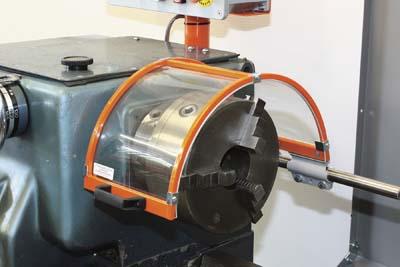
Rockford Systems Inc. offers a new line of electrically interlocked heavy-duty lathe shields. The use of these electrically interlocked lathe shields goes beyond OSHA and ANSI safety requirements.
These lathe shields have a thermo-formed, impact-resistant, transparent polycarbonate shield that protects operators from direct contact with the upper portion of the rotating chuck. The heavy-duty tubular-steel frame is attached with a steel clamp to support a rotating arm that operates the safety microswitch. When the lathe shield is lifted up, the positive contacts on the microswitch open, sending a stop signal to the machine control. The safety microswitch has an enclosure rating of IP 67 with a mechanical life of one million switching cycles.
These heavy-duty interlocked shields are available in several sizes.
Contact Details
Related Glossary Terms
- chuck
chuck
Workholding device that affixes to a mill, lathe or drill-press spindle. It holds a tool or workpiece by one end, allowing it to be rotated. May also be fitted to the machine table to hold a workpiece. Two or more adjustable jaws actually hold the tool or part. May be actuated manually, pneumatically, hydraulically or electrically. See collet.
- lathe
lathe
Turning machine capable of sawing, milling, grinding, gear-cutting, drilling, reaming, boring, threading, facing, chamfering, grooving, knurling, spinning, parting, necking, taper-cutting, and cam- and eccentric-cutting, as well as step- and straight-turning. Comes in a variety of forms, ranging from manual to semiautomatic to fully automatic, with major types being engine lathes, turning and contouring lathes, turret lathes and numerical-control lathes. The engine lathe consists of a headstock and spindle, tailstock, bed, carriage (complete with apron) and cross slides. Features include gear- (speed) and feed-selector levers, toolpost, compound rest, lead screw and reversing lead screw, threading dial and rapid-traverse lever. Special lathe types include through-the-spindle, camshaft and crankshaft, brake drum and rotor, spinning and gun-barrel machines. Toolroom and bench lathes are used for precision work; the former for tool-and-die work and similar tasks, the latter for small workpieces (instruments, watches), normally without a power feed. Models are typically designated according to their “swing,” or the largest-diameter workpiece that can be rotated; bed length, or the distance between centers; and horsepower generated. See turning machine.
